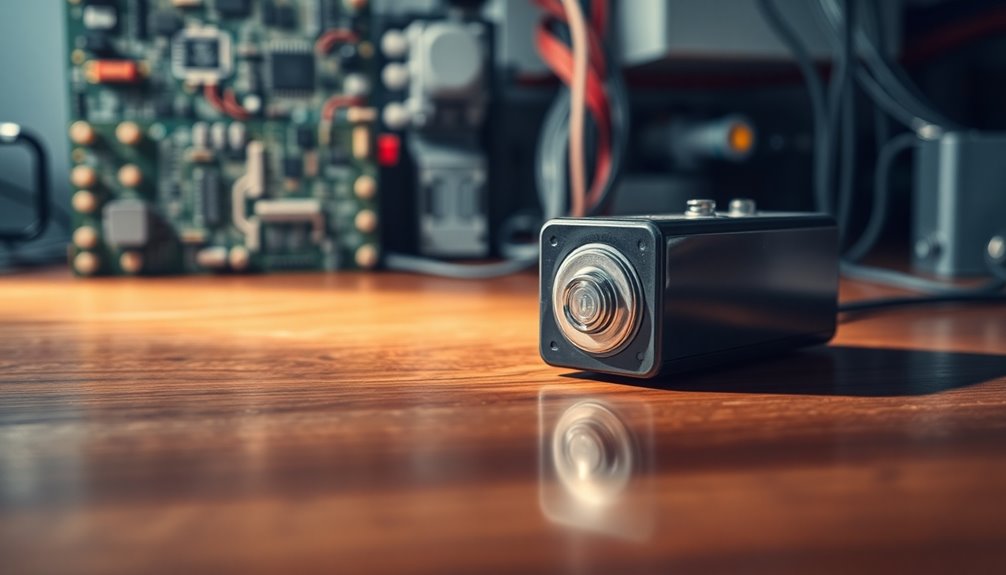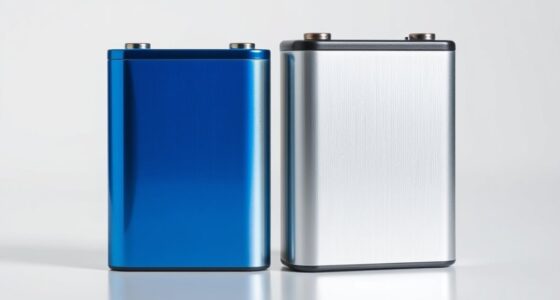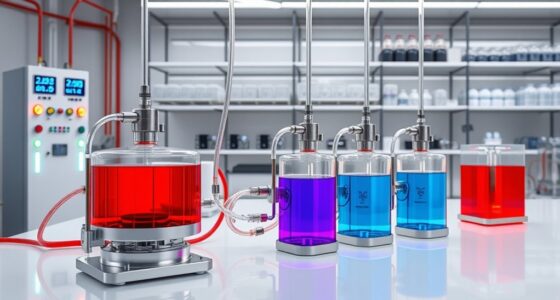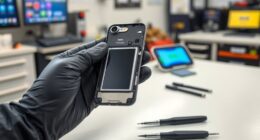Batteries produce direct current (DC), which means they provide a steady flow of energy essential for your devices. Unlike alternating current (AC), which flows periodically and is great for long-distance transmission, batteries guarantee a consistent power output through chemical reactions. Most of your electronic gadgets use DC, even if they initially run on AC. To use battery power with AC devices, you'll need an inverter to convert the DC into AC. Understanding this difference is critical for safely powering your electronics and optimizing their performance. If you stick around, you'll uncover even more about this fascinating topic!
Key Takeaways
- Batteries inherently generate Direct Current (DC) through chemical reactions, ensuring a steady flow of electrons for device operation.
- Common battery types, like AA and lithium-ion, provide reliable DC power for various applications, including portable electronics.
- "AC batteries" require inverters to convert their stored DC into Alternating Current (AC) for use with larger appliances.
- Understanding the differences between AC and DC is crucial, as most electronic devices operate on AC but internally convert it from DC.
- Knowledge of power types helps avoid device damage and ensures optimal performance, making compatibility considerations essential in energy management.
Understanding AC and DC
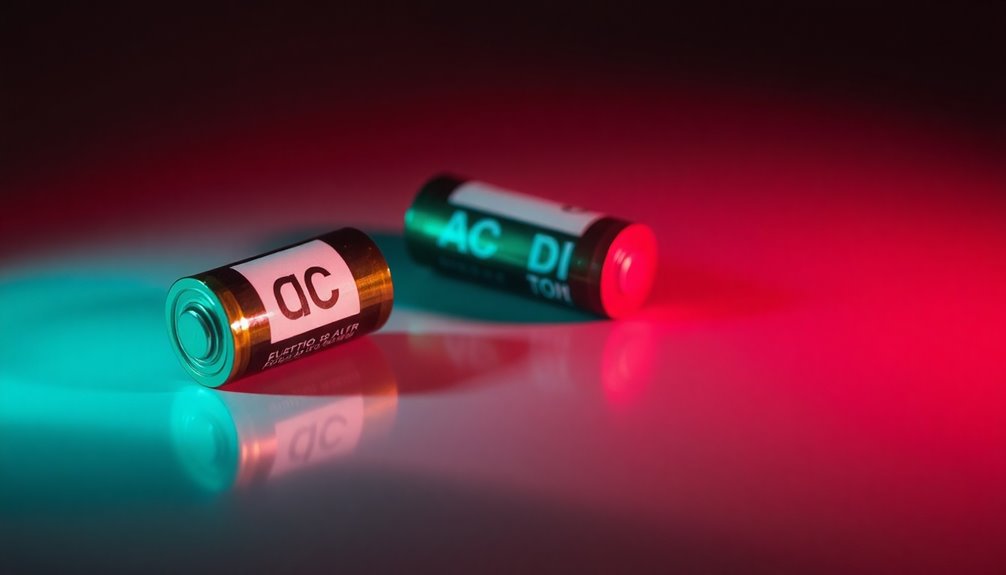
When you plug in your devices at home, understanding the difference between Alternating Current (AC) and Direct Current (DC) is vital.
AC power flows in a periodic direction, making it ideal for long-distance transmission and household power supply. Most electronic devices operate on AC but internally convert it to DC for stability.
On the other hand, batteries use direct current, providing a steady flow of DC that's essential for portable electronics and renewable energy systems. Since no batteries supply AC power directly, inverters are necessary to convert DC to AC for those devices.
Characteristics of Batteries
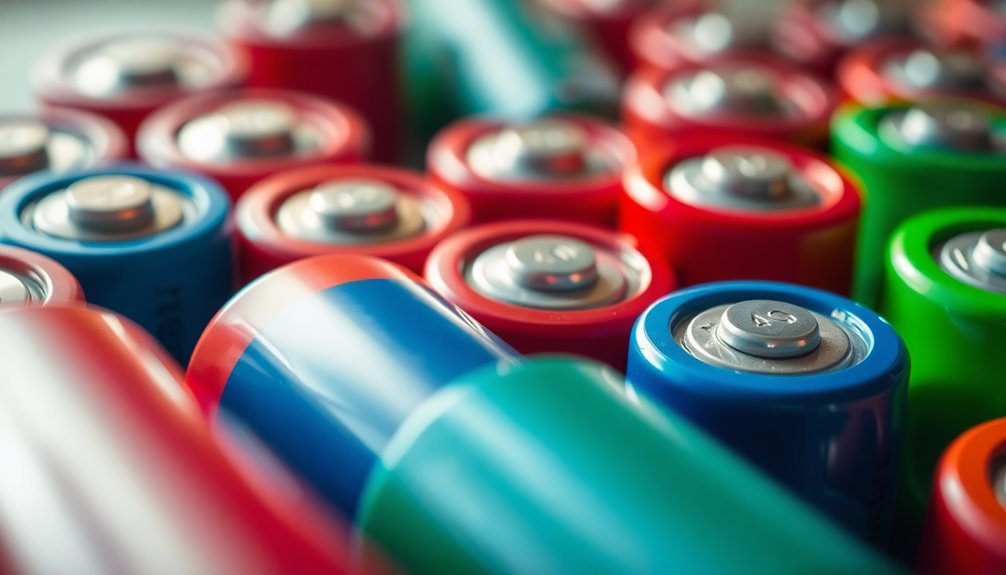
Batteries are essential for powering many of your devices, relying on chemical reactions to generate direct current.
This one-way flow of electrons guarantees stable and reliable energy delivery, perfect for everything from remote controls to electric vehicles.
Understanding how batteries function and their direct current characteristics can help you choose the right power source for your needs.
Battery Functionality Overview
There's a lot to appreciate about how batteries function, as they harness chemical reactions to produce direct current (DC).
This one-way flow of electrons is essential for powering various electronic devices, providing stable voltage output, typically between 1.2V and 12V. For instance, a 12V DC battery is commonly used in cars and solar energy systems, ensuring reliable power.
It's significant to recognize that all batteries inherently generate DC power, while some devices may be labeled as "AC batteries," requiring inverters for AC compatibility.
Additionally, modern batteries come equipped with a battery management system (BMS) that monitors and protects their performance, enhancing safety and longevity across different applications.
Understanding these characteristics helps you appreciate the role of batteries in everyday life.
Direct Current Characteristics
Understanding direct current (DC) characteristics is essential for grasping how batteries power our devices. Batteries generate DC electricity, creating a consistent flow of electrons from the positive to the negative terminal.
This one-way flow is vital for powering everything from small electronics to rechargeable devices. The voltage, like that of a 12V battery, indicates the electrical potential available for your devices.
DC is particularly suited for energy storage, as it maintains a steady voltage, making it efficient for renewable energy systems. While some systems might market themselves as "AC batteries," they simply use inverters to convert stored DC power into AC.
Why Batteries Use DC

Batteries use direct current (DC) because their chemical reactions create a one-way flow of electrons, which is essential for powering your devices.
This stable power supply guarantees that gadgets like your flashlight or smartphone operate reliably.
Without DC, many of your everyday electronics wouldn't function as intended.
Chemical Reactions Generate DC
When you think about how batteries power your devices, it's vital to recognize that chemical reactions inside them create a one-way flow of electrons, generating direct current (DC).
This flow is essential for electronic devices, providing stable DC power that guarantees peak performance. Common battery types, like AA and lithium-ion, are designed to deliver reliable DC power, maintaining consistent voltage and amperage.
Unlike alternating current (AC), which changes direction, the steady output from batteries is ideal for various applications. Even a typical 12V battery, widely used in cars and renewable energy systems, exemplifies this reliable DC power.
It's significant to mention that any so-called "AC batteries" actually contain inverters, converting their inherent DC power to AC for appliance usage.
Stable Power for Devices
While many devices rely on consistent power to function effectively, the direct current (DC) supplied by batteries guarantees they receive that stability. This one-way flow of electrical current is essential for various applications, ensuring devices operate smoothly without the risks associated with AC power.
Here are three key reasons why DC is preferred:
- Stable Voltage: DC eliminates fluctuations, preventing overheating and potential damage to sensitive electronics.
- Compatibility with Battery Types: Common batteries like AA and lithium-ion inherently provide DC, making them ideal for smartphones, laptops, and electric vehicles.
- Renewable Energy Integration: DC batteries, especially in solar energy systems, allow for reliable power storage and use, enhancing off-grid solutions.
Inverters are needed when AC devices are used with batteries, highlighting the dominance of DC in battery technology. Additionally, the importance of AI security in protecting data from cyber threats is increasingly relevant as electronic devices become more interconnected.
Impact of DC on AC Devices
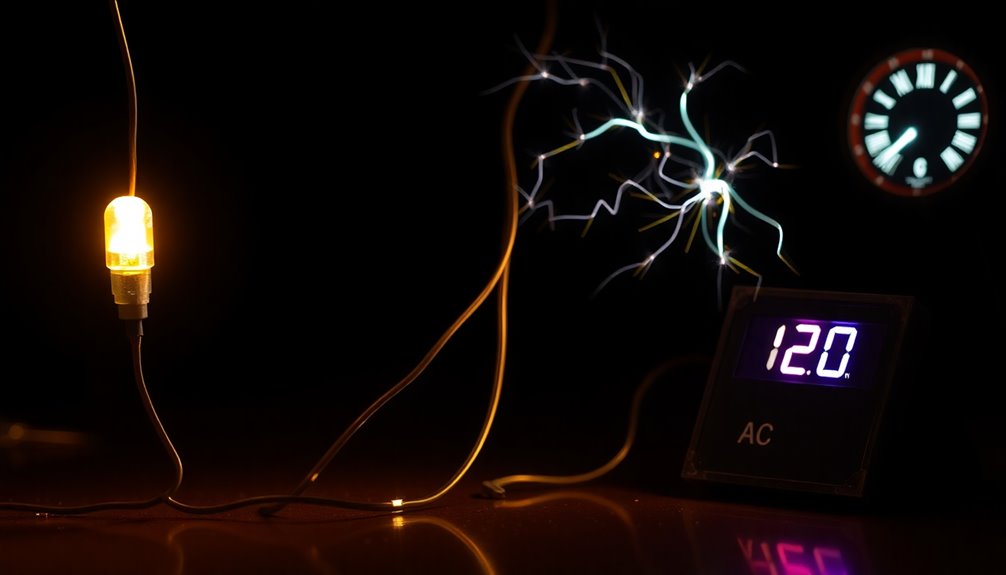
Connecting DC power to AC devices can lead to serious complications if you don't take the necessary precautions.
AC devices rely on alternating current's voltage changes, which DC can't replicate. If you connect them directly to a DC power source like batteries, it can cause overheating or even damage your electronic components.
To avoid this, you'll need an inverter to convert the DC from your batteries into usable AC power. This guarantees compatibility with your household appliances, such as refrigerators and TVs, which need AC power to function properly.
Remember, running AC devices on DC without an inverter not only risks damage but could also void warranties. Understanding the concept of interest rates is also crucial when considering the costs associated with purchasing an inverter and maintaining your power system.
Common Applications of DC Batteries
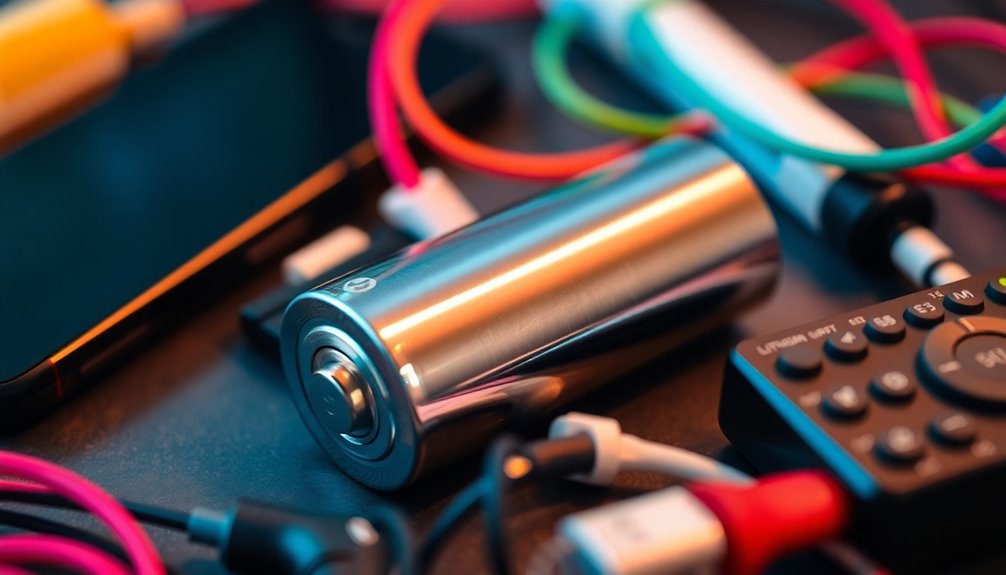
DC batteries are vital in powering a variety of devices you encounter daily. They provide a reliable energy source for:
- Small electronics: Devices like flashlights and remote controls depend on DC batteries for their operation.
- Rechargeable devices: Smartphones and laptops utilize lithium-ion DC batteries, enabling multiple charge cycles for portable energy.
- Electric vehicles: Large DC battery systems power EV motors and electronics, promoting sustainable transportation.
Additionally, DC batteries play an important role in renewable energy systems. Solar panels generate DC electricity that's stored in batteries for later use, especially in off-grid applications like RVs and camping.
These setups rely on DC batteries to guarantee a consistent power supply, making them indispensable in modern life. Furthermore, the integration of renewable energy sources enhances the sustainability and efficiency of these battery systems.
Renogy Battery Solutions
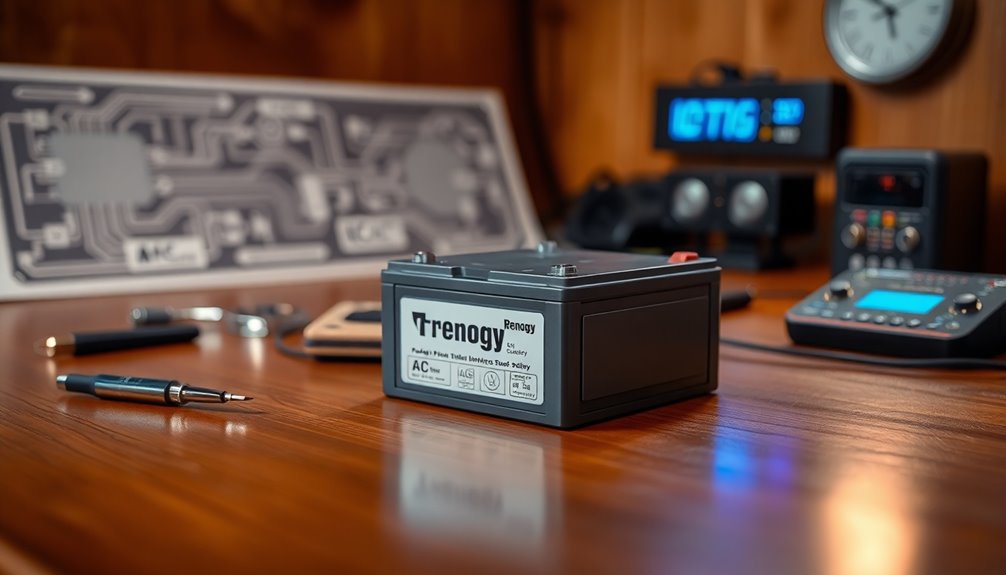
Renogy battery solutions stand out in the domain of energy storage, offering innovative options to meet your power needs.
Their range of DC batteries, like the Core Mini – 12.8V 300Ah, features high energy density and a built-in battery management system (BMS) for enhanced monitoring and protection.
If you're looking for compact power, the Core Mini – 12.8V 100Ah battery is lightweight and perfect for small electrical devices in RVs or solar setups.
Designed for reliability, these batteries include low-temperature cutoff BMS, ensuring safe operation even in cold environments.
With a focus on renewable energy systems, Renogy provides reliable storage for solar-generated DC electricity, making them an excellent choice for off-grid energy solutions that meet diverse energy management needs. Additionally, these batteries play a critical role in enhancing crop yields through efficient energy use in solar-powered irrigation systems.
Power Conversion and Compatibility
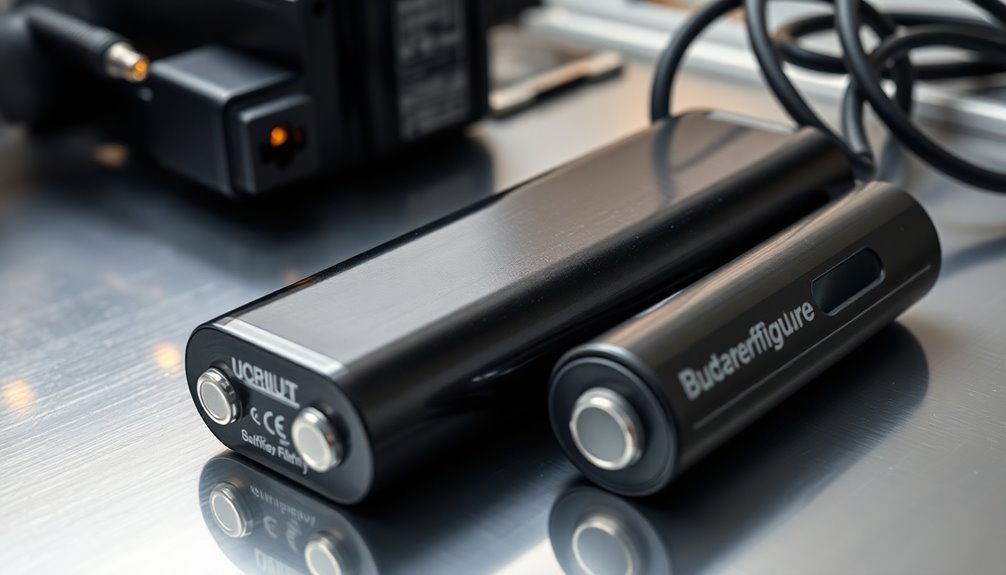
When it comes to using batteries for various applications, understanding power conversion and compatibility is key. Batteries provide DC (direct current) through chemical reactions, making them essential for many devices.
However, when you need AC electricity for appliances, you'll encounter compatibility issues. An inverter converts the DC into usable AC power.
Here are three important considerations:
- Applications: DC is ideal for small electronics, while AC suits larger appliances.
- Power Conversion: An inverter is necessary for converting the DC to AC.
- Transmitting Electricity: AC is preferred for long-distance transmission due to its efficiency.
Understanding the differences between current (AC) and direct current (DC) guarantees you choose the right power source, avoiding damage to your devices.
Key Takeaways on Power Types
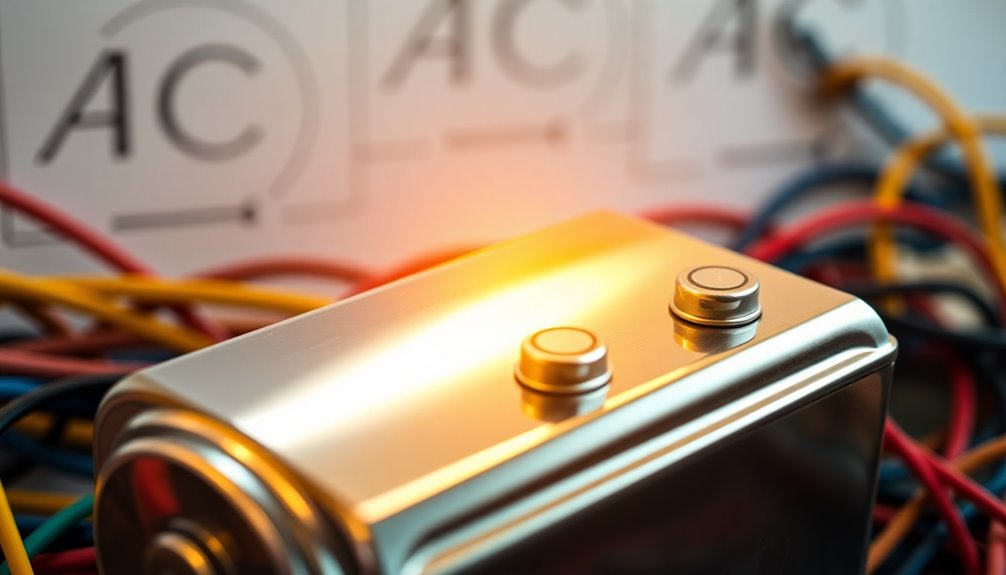
Understanding the differences between AC and DC power types can considerably impact your choice of energy sources for various applications.
Batteries produce direct current (DC) electricity, enabling a one-way flow of electrons through chemical reactions. Common examples include AA and lithium-ion batteries, widely used in small devices and renewable energy systems.
While marketed as "AC batteries," these actually contain inverters to convert stored DC power to usable AC power. Remember, DC is ideal for applications needing stable voltage, like electric vehicles and off-grid solutions.
It's essential to grasp the distinction between AC and DC to guarantee device compatibility and safe energy usage, as AC devices can't operate on DC without conversion. Additionally, understanding tax advantages associated with different energy investments can help optimize your financial planning for future energy needs.
Choose wisely for your energy needs!
Frequently Asked Questions
Are Batteries AC or DC Power?
Batteries produce DC power, meaning they deliver a steady, one-way flow of electrons.
When you use a battery to power your devices, you're tapping into this direct current. Common examples include AA and lithium-ion batteries, both of which are essential for many gadgets.
Even if you recharge a battery from an AC source, the electricity it provides is still DC.
Why Is DC Current Not Used in Homes?
DC current isn't used in homes mainly because it struggles with long-distance power transmission.
You'd find it inefficient for delivering electricity over those distances, unlike AC, which can easily be transformed to higher voltages.
Plus, most household appliances are designed for AC, making it impractical to switch everything to DC.
The existing infrastructure and cost of converting DC voltage also make AC the more favorable choice for residential power supply.
Why Use AC Current Instead of DC?
Have you ever wondered why most homes light up with a flicker instead of a steady glow?
You use AC current because it's more efficient for long distances and can easily transform to different voltages. This versatility makes it perfect for household appliances and industrial motors, giving them the power they need without energy loss.
Plus, with smart technologies integrated into AC systems, you get real-time monitoring to optimize your energy use.
Are Alkaline Batteries AC or DC?
Alkaline batteries are DC devices, so they produce a steady one-way flow of electricity.
When you use AA or AAA batteries, you're getting 1.5 volts of reliable DC power, perfect for your remote controls and flashlights.
Unlike AC, which changes direction, the output from alkaline batteries stays constant until they run out.
Conclusion
In the world of power, batteries symbolize the steady heartbeat of technology, delivering direct current (DC) that fuels our devices. Just like a river flowing smoothly, DC provides a consistent energy source, essential for countless applications. While alternating current (AC) powers our homes, it's the unwavering pulse of DC from batteries that keeps our gadgets alive. So, next time you plug in, remember the silent strength of batteries, quietly fueling your digital life with unmatched reliability.

